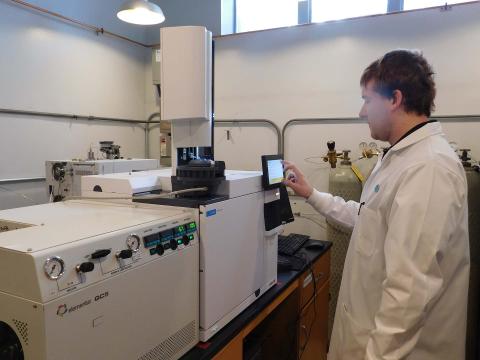This spring, the Water Sciences Laboratory installed equipment to expand its research capabilities in stable isotope testing. The new instrument, known as a compound specific isotope analyzer (CSIA), will allow the Water Sciences Laboratory to create new methods in measuring isotope composition of organic compounds like fatty acids. While there are numerous applications for this type of method, the first method to be developed is intended to provide researchers and resources managers with the tools to track erosion on a watershed level to determine the effectiveness of existing management strategies.
Soil erosion is a constant challenge to watershed management throughout the Great Plains and CSIA can provide an “isotope fingerprint” unique to different soil types and land use. The Water Sciences Laboratory will use the Johnson Creek watershed as a case study in Nebraska to develop the method and determine its effectiveness in tracing sediment deposition and erosion sources in Nebraska. Researchers collected samples from a reservoir in Johnson Creek and a small reservoir near the Eastern Nebraska Research and Extension Center and will test isotope abundance to see how well this “fingerprinting” technique will work.
CSIA precisely measures the abundance of the stable isotopes of hydrogen, carbon, and nitrogen of organic compounds extracted from water, soils, and biological tissues. Fingerprinting eroded soil deposited in a reservoir is only one application of this technique. The lab will also be able to develop methods for isotope analysis of amino acids and other naturally occurring soil organic matter, and potentially use the equipment for fingerprinting pesticides and other organic contaminants. This technique is widely used for measuring metabolic and transformation processes that are occurring in soils, sediment, and water.
The Water Sciences Laboratory will be the only lab in the state with the capabilities to measure isotope abundance in organic compounds. Water Sciences Laboratory Director Daniel Snow spoke to the wide range of groups that may be interested in this type of testing.
“Researchers are the main clientele as we develop the method and see how well it works,” Snow said. “In the future this type of testing could be used by Natural Resources Districts, the Department of Natural Resources, and others who are managing water resources in Nebraska. Compound specific isotope analysis of fatty acids can answer the question, if you’re spending money to control erosion in a watershed, is that money going to the right locations? Compound specific isotope analysis of fatty acids will help see what areas are contributing eroded soil to a specific impoundment. Watershed management can then target specific areas for controlling erosion, thereby reducing costs of dredging and maintaining reservoirs subject to rapid sedimentation. Erosion is a huge problem everywhere, so if we can use this to control erosion then it’s a great thing.”
Isotope analysis of fatty acid methyl esters, also known as FAMES, in soils and sediments can also be used for other purposes such as measuring soil carbon turnover, soil health, and microbial activity. Other methods will be developed to identify isotope composition in specific contaminants to track sources and understand degradation. The methods will also include understanding how organic nitrogen is converted into nitrate. Future applications could also include analyzing carbon sources and better understanding food web interactions and the sources of food in specific organisms.
Many of the research applications that the new compound specific isotope analyzer is used for will be novel test methods created by the Water Sciences Laboratory team. The Water Sciences Laboratory is in a unique position to continually develop new methods to address current water research concerns. Daniel Snow explained, “Nebraska supports this kind of lab. The university and the state see value in it and have continuously support the Water Sciences Laboratory for the past 30 years.” The combination of external laboratory support and a highly skilled internal team allows the Water Sciences Laboratory to continue to develop unique testing methods for use in specialized research and natural resource management.
The Water Sciences Laboratory is able to focus on research and method development because of the support of the state and the priorities of their clients. Commercial labs are often unable to focus on method development because research is not their main priority, which in turn means the Water Sciences Laboratory isn’t competing with commercial labs for clients.
Funding for the CSIA system originated from several sources. The Nebraska Research Initiative contributed a majority of the funding. Additional support was provided by the Nebraska Water Center’s 104B program, the United States Department of Agriculture’s Agricultural Research Service (USDA ARS), the Daugherty Water for Food Global Institute, and the Institute of Agriculture and Natural Resources, the Agricultural Research Division, and the Office of Research and Economic Development at the University of Nebraska – Lincoln. The Water Sciences Laboratory and the Nebraska Water Center spent almost three years coordinating the funding sources for the new compound specific isotope analyzer.
To make room for the new equipment, the Water Sciences Laboratory team retired its oldest isotope analyzer and renovated one of their existing laboratory rooms. This renovation included acquiring a custom bench and optimizing the existing space so the new equipment can be effectively used. The renovated laboratory room also provides space for the previously existing equipment, which has been upgraded to function in tandem with the compound specific isotope analyzer.
Samples are already being run in the new laboratory setup. With each use, the equipment will continue to be fine-tuned and improved. “Like any isotope method,” Snow explained, “the more you use it the more you can figure out research applications that it works best for”.
The compound specific isotope analyzer complements existing equipment measuring isotopes in nitrate, phosphate, bulk hydrogen, carbon, nitrogen, and oxygen. The new technology will provide the Water Sciences Laboratory with capabilities to help solve another piece of the water quality puzzle, improving research and resource management opportunities in Nebraska and beyond.

